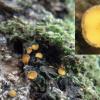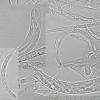
09-12-2025 12:06
 Andgelo Mombert
Andgelo Mombert
Bonjour,Je recherche l'article concernant Hypobryo

12-12-2025 18:39
Mirek GrycHello everyone.Macrofeatures similar to Mollisia b

07-12-2025 16:07
Arnold BüschlenHallo, ich habe in einer Moos-Aufsammlung (epiphy

08-12-2025 21:04
Mark Stevens"Hello everyone,I'm relatively new to microscopy (

08-12-2025 18:59
 Lothar Krieglsteiner
Lothar Krieglsteiner
.. found by a seminar-participant, I do not know t

08-12-2025 17:37
 Lothar Krieglsteiner
Lothar Krieglsteiner
20.6.25, on branch of Abies infected and thickened
inoperculate discomycete from ethiopia
Uwe Lindemann,
02-11-2008 01:23
at the end of september 2008 I found in addis abeba (ethiopia) a difficult inoperculate discomycete, growing on bark of a broadleaf tree (ficus?).
Macroscopic features:
Apothecia: 2-3 mm diameter, yellow, sessile, at the margin with brown hairs
Microscopic features:
Ascus: 110-130 x 10 ym, without crozier, containing 8 parallel lying ascospores, porus in IKI blue
Ascospores: 48-58 x 2,5-3,5 ym, hyalin, 6-8 septate, filiform, strongly curved
Paraphyses: lanceolate
Hairs: brown, 80 x 4,5 ym, septate, thick-walled, obtuse
What do you think about this discomycete? I have no idea...
Thank you very much for your help!
Best wishes
Uwe
Stip Helleman,
02-11-2008 03:32

Re:inoperculate discomycete from ethiopia
Hello Uwe,
This species resembles the genus Trichopeziza, i think it is the so called species Lachnum indicum (Cash) Haines & Dumont. To my knowledge no combination in Trichopeziza is made.
best wishes,
Stip
This species resembles the genus Trichopeziza, i think it is the so called species Lachnum indicum (Cash) Haines & Dumont. To my knowledge no combination in Trichopeziza is made.
best wishes,
Stip
Stip Helleman,
02-11-2008 03:44

Re:inoperculate discomycete from ethiopia
You can download the Haines & Dumont article here
http://helotiales.nl/doorgeefluik/Long-spored%20lignicolous%20Lachnum-Haines.pdf
Stip
http://helotiales.nl/doorgeefluik/Long-spored%20lignicolous%20Lachnum-Haines.pdf
Stip
Uwe Lindemann,
02-11-2008 08:58
Re:inoperculate discomycete from ethiopia
Hello Stip, thank you very much for your fast help! My collectrion is very similar to Lachnum indicum which is described in the article.
Best wishes
Uwe
Best wishes
Uwe

